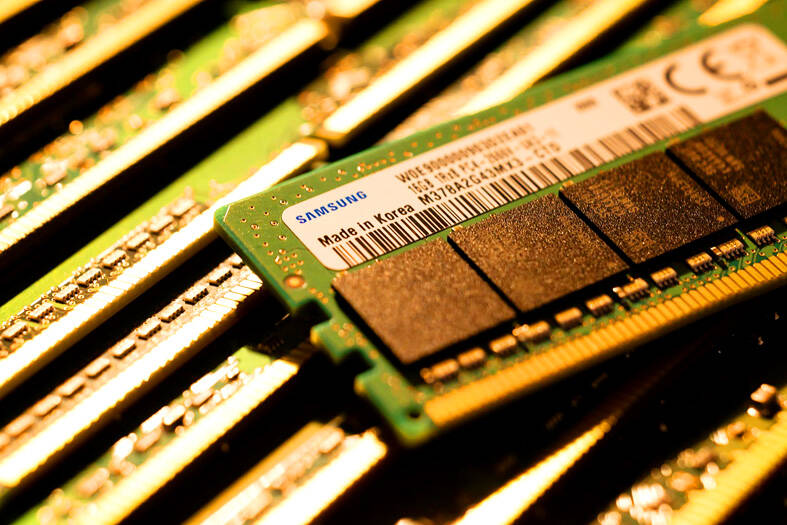The contract prices of DRAM chips are to rise by as much as 18 percent sequentially this quarter — the first price upticks in about eight quarters — driven mainly by inventory rebuilding demand for DRAM chips used in mobile devices and PCs, TrendForce Corp (集邦科技) projected yesterday.
The price rebound is led by a quarterly increase of mobile DRAM chips, which are to climb between 13 percent and 18 percent quarter-on-quarter this quarter, which has not been seen since the fourth quarter of 2021, the Taipei-based market researcher predicted.
Likewise, the price of mainstream PC DDR4 DRAM is expected to bounce back for the first time in about two years at a quarterly pace of 9.6 percent this quarter, the researcher said, adding that the prices have plummeted 64 percent since the final quarter of 2021.

Photo: Bloomberg / Seong-Joon Cho
As the pickup remains lukewarm, TrendForce expects DRAM chipmakers to see scant growth in shipments this quarter. Additionally, the researcher has a conservative outlook for server DRAM chips, given that inventory continues to hover at a high level.
As a result, Samsung Electronics Co — the world’s largest memorychip maker — is to accelerate its capacity reduction this quarter by slashing mainstream DDR4 chip production by 30 percent to alleviate inventory pressure, TrendForce said.
Last quarter, the world’s major DRAM chipmakers saw their revenue increase 18 percent sequentially to total US$13.48 billion, benefiting from a gradual improvement in demand during the second half of this year, TrendForce said in a report yesterday.
Samsung registered 15.9 percent quarterly growth in revenue to US$5.25 billion, as the South Korean memorychip maker started cranking out its first new-generation 1-alpha-nanometer DDR5 chips, which delivered a price premium, the report said.
SK Hynix Inc, the world’s second-largest memorychip maker, enjoyed the strongest revenue growth of 34.4 percent sequentially to US$4.63 billion, supported by robust demand for high-bandwidth memory and DDR5 chips, which were mostly used in artificial-intelligence servers, the report said. SK Hynix has seen shipments rise for a third consecutive quarter beginning last quarter, with memorychip prices jumping 10 percent quarterly, it said.
US memorychip maker Micron Technology Inc reported a 4.2-percent growth in revenue to US$3.08 billion last quarter, attributable to shipment expansion, while it saw a mild decline in average selling price last quarter from the previous quarter.
Taiwan’s Nanya Technology Corp (南亞科技) saw revenue grow 10 percent quarterly last quarter to about US$244 million, thanks to shipment increases at a quarterly rate between 17 and 19 percent due to improving PC DRAM demand. However, demand for its major DDR3 and DDR4 products remained sluggish last quarter, as prices for these chips extended in a downward trend from the previous quarters.
Winbond Electronics Corp (華邦電) and Powerchip Semiconductor Manufacturing Corp (力積電) saw their DRAM revenue sequentially rise 13 percent and 4.4 percent respectively last quarter, TrendForce said.

The US dollar was trading at NT$29.7 at 10am today on the Taipei Foreign Exchange, as the New Taiwan dollar gained NT$1.364 from the previous close last week. The NT dollar continued to rise today, after surging 3.07 percent on Friday. After opening at NT$30.91, the NT dollar gained more than NT$1 in just 15 minutes, briefly passing the NT$30 mark. Before the US Department of the Treasury's semi-annual currency report came out, expectations that the NT dollar would keep rising were already building. The NT dollar on Friday closed at NT$31.064, up by NT$0.953 — a 3.07 percent single-day gain. Today,

‘SHORT TERM’: The local currency would likely remain strong in the near term, driven by anticipated US trade pressure, capital inflows and expectations of a US Fed rate cut The US dollar is expected to fall below NT$30 in the near term, as traders anticipate increased pressure from Washington for Taiwan to allow the New Taiwan dollar to appreciate, Cathay United Bank (國泰世華銀行) chief economist Lin Chi-chao (林啟超) said. Following a sharp drop in the greenback against the NT dollar on Friday, Lin told the Central News Agency that the local currency is likely to remain strong in the short term, driven in part by market psychology surrounding anticipated US policy pressure. On Friday, the US dollar fell NT$0.953, or 3.07 percent, closing at NT$31.064 — its lowest level since Jan.

The New Taiwan dollar and Taiwanese stocks surged on signs that trade tensions between the world’s top two economies might start easing and as US tech earnings boosted the outlook of the nation’s semiconductor exports. The NT dollar strengthened as much as 3.8 percent versus the US dollar to 30.815, the biggest intraday gain since January 2011, closing at NT$31.064. The benchmark TAIEX jumped 2.73 percent to outperform the region’s equity gauges. Outlook for global trade improved after China said it is assessing possible trade talks with the US, providing a boost for the nation’s currency and shares. As the NT dollar

The Financial Supervisory Commission (FSC) yesterday met with some of the nation’s largest insurance companies as a skyrocketing New Taiwan dollar piles pressure on their hundreds of billions of dollars in US bond investments. The commission has asked some life insurance firms, among the biggest Asian holders of US debt, to discuss how the rapidly strengthening NT dollar has impacted their operations, people familiar with the matter said. The meeting took place as the NT dollar jumped as much as 5 percent yesterday, its biggest intraday gain in more than three decades. The local currency surged as exporters rushed to